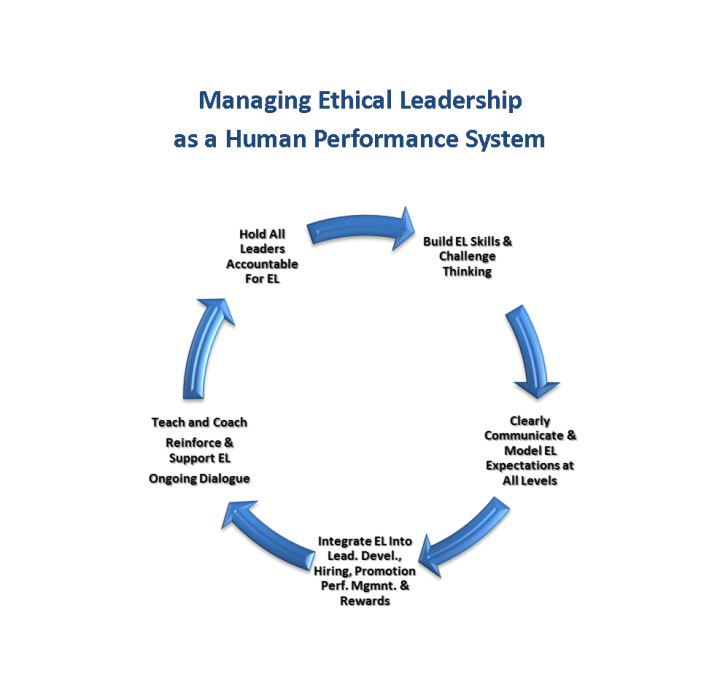By Linda Fisher Thornton
When we think about ethical leadership as a performance system, we get a higher level view of what it takes to develop ethical leaders. This graphic shows what an integrated ethical leadership performance management system might look like (EL refers to ethical leadership).

The components of an ethical leadership performance management system are mutually reinforcing and must be closely aligned. If just one element shown on this graphic is missing, then the rest of the components will not work effectively. For example, clear communication about expected ethical behavior is important, but it isn’t likely to lead to ethical behavior unless you also holding people accountable for meeting the expectations.
An integrated system has:
- alignment
- clarity
- positive role models
- ongoing conversation
- learning and practice
- support
- accountability, and
- positive, proactive performance management
In Talking Values LRN: Bringing a “Pull” approach to Ethics and Compliance, Michael Bramnick shares his insights about “‘pull’ approaches to compliance that make training, codes of conduct, and related processes meaningful to employees.” Pull approaches give employees a positive reason to engage in ethical behavior, rather than relying on punishments or reprimands. They support employee engagement in the direction of the ethical leadership we expect. They add positive power to the whole performance system.

For more, see new book 7 Lenses and the 21 Question Assessment: How Current is My Message About Ethics?
 2014 Axiom Business Book Award Winner
About 7 Lenses
Info@LeadinginContext.com @leadingincontxt @7Lenses
2014 Axiom Business Book Award Winner
About 7 Lenses
Info@LeadinginContext.com @leadingincontxt @7Lenses
© 2013 Leading in Context LLC
Reblogged this on kwalitisme.
LikeLike
Cam, You have put your finger right on the big challenge (and opportunity) – We need clarity about what ethical leadership looks like in action. I saw in your book acknowledgements that you learned from Dr. Covey – I was fortunate to be certified by the Covey Leadership Center early in my career to teach the 7 Habits to leader groups, and learned a great deal from that experience. I’m glad that you are actively seeking to provide clarity on “where the bar is” for ethical leaders – that is my life’s work as well.
LikeLike
Linda, I think the major problem with any model about “ethical” leadership is in defining what it means to be ethical. Virtually every individual self-describes as being an ethical person. However, the Maritz Research (2011) study indicates that very few of us trust our leaders and do not consider them to be worthy of that trust. There’s the dichotomy.
Bennis and Nanus (2007) tell us that we need a new “transformative” model of ethical leadership that raises the ethical leadership standard. I am convinced that the model you offer must begin with a clear articulation of where the bar really is about ethical behavior.
Three of my students and I have just written a paper that describes the qualities of virtuous leadership. Last year, I wrote a book that identified the importance of the leader as an ethical steward and that incorporated the ethical priorities of six highly-regarded leadership perspectives. Perhaps we need more dialog about what constitutes ethical leadership behaviors and exactly where the bar is for leaders to be perceived as trustworthy.
LikeLike